Climate Risk Management Strategies for Dairy Farming Business
VerifiedAdded on 2019/12/28
|10
|2806
|142
Report
AI Summary
This report delves into climate risk management strategies within the dairy farming sector, focusing on the environmental impact of climate change, particularly in Victoria. It examines the effects of changing temperatures, rainfall patterns, and the Southern Oscillation Index (SOI) on dairy farms. The report outlines a risk assessment using a risk matrix and a vulnerability matrix to identify potential challenges and opportunities. It further proposes risk management strategies, including adaptive approaches like integral methods and flexibility in resource management. The analysis highlights the importance of understanding climate variability and its direct impact on farming business profitability, emphasizing the need for proactive measures to mitigate risks and ensure sustainable dairy production.
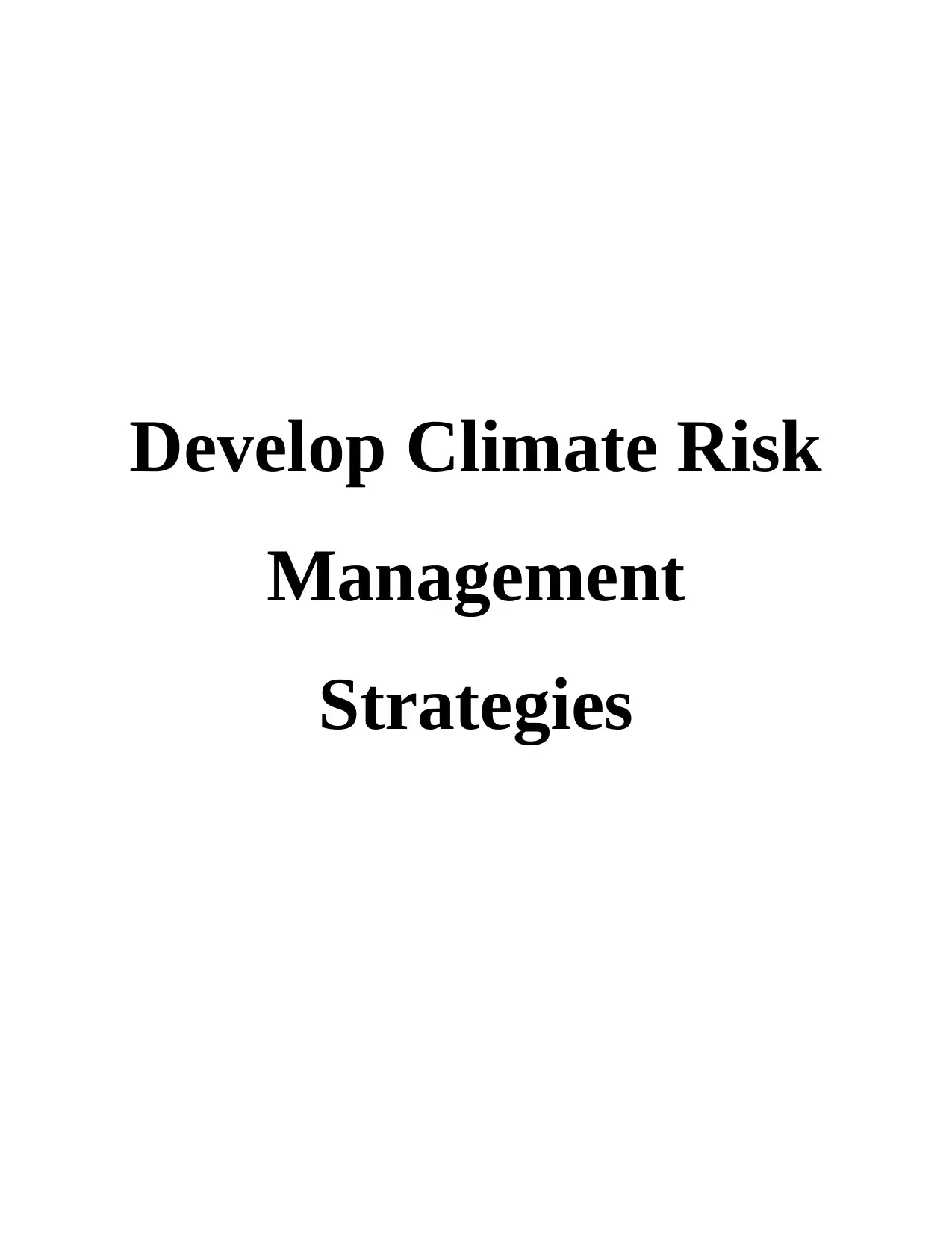
Develop Climate Risk
Management
Strategies
Management
Strategies
Paraphrase This Document
Need a fresh take? Get an instant paraphrase of this document with our AI Paraphraser
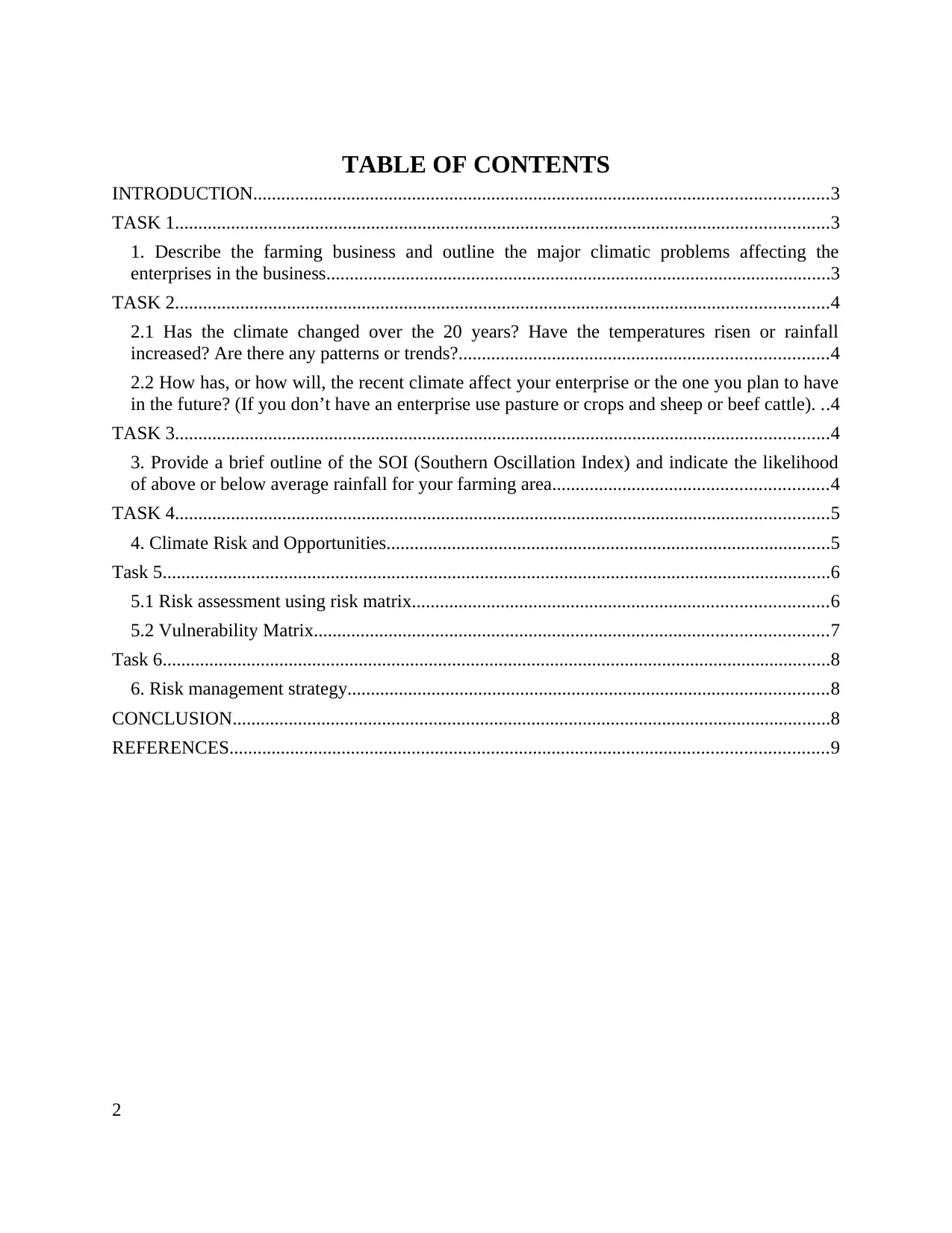
TABLE OF CONTENTS
INTRODUCTION...........................................................................................................................3
TASK 1............................................................................................................................................3
1. Describe the farming business and outline the major climatic problems affecting the
enterprises in the business............................................................................................................3
TASK 2............................................................................................................................................4
2.1 Has the climate changed over the 20 years? Have the temperatures risen or rainfall
increased? Are there any patterns or trends?...............................................................................4
2.2 How has, or how will, the recent climate affect your enterprise or the one you plan to have
in the future? (If you don’t have an enterprise use pasture or crops and sheep or beef cattle). ..4
TASK 3............................................................................................................................................4
3. Provide a brief outline of the SOI (Southern Oscillation Index) and indicate the likelihood
of above or below average rainfall for your farming area...........................................................4
TASK 4............................................................................................................................................5
4. Climate Risk and Opportunities...............................................................................................5
Task 5...............................................................................................................................................6
5.1 Risk assessment using risk matrix.........................................................................................6
5.2 Vulnerability Matrix..............................................................................................................7
Task 6...............................................................................................................................................8
6. Risk management strategy.......................................................................................................8
CONCLUSION................................................................................................................................8
REFERENCES................................................................................................................................9
2
INTRODUCTION...........................................................................................................................3
TASK 1............................................................................................................................................3
1. Describe the farming business and outline the major climatic problems affecting the
enterprises in the business............................................................................................................3
TASK 2............................................................................................................................................4
2.1 Has the climate changed over the 20 years? Have the temperatures risen or rainfall
increased? Are there any patterns or trends?...............................................................................4
2.2 How has, or how will, the recent climate affect your enterprise or the one you plan to have
in the future? (If you don’t have an enterprise use pasture or crops and sheep or beef cattle). ..4
TASK 3............................................................................................................................................4
3. Provide a brief outline of the SOI (Southern Oscillation Index) and indicate the likelihood
of above or below average rainfall for your farming area...........................................................4
TASK 4............................................................................................................................................5
4. Climate Risk and Opportunities...............................................................................................5
Task 5...............................................................................................................................................6
5.1 Risk assessment using risk matrix.........................................................................................6
5.2 Vulnerability Matrix..............................................................................................................7
Task 6...............................................................................................................................................8
6. Risk management strategy.......................................................................................................8
CONCLUSION................................................................................................................................8
REFERENCES................................................................................................................................9
2
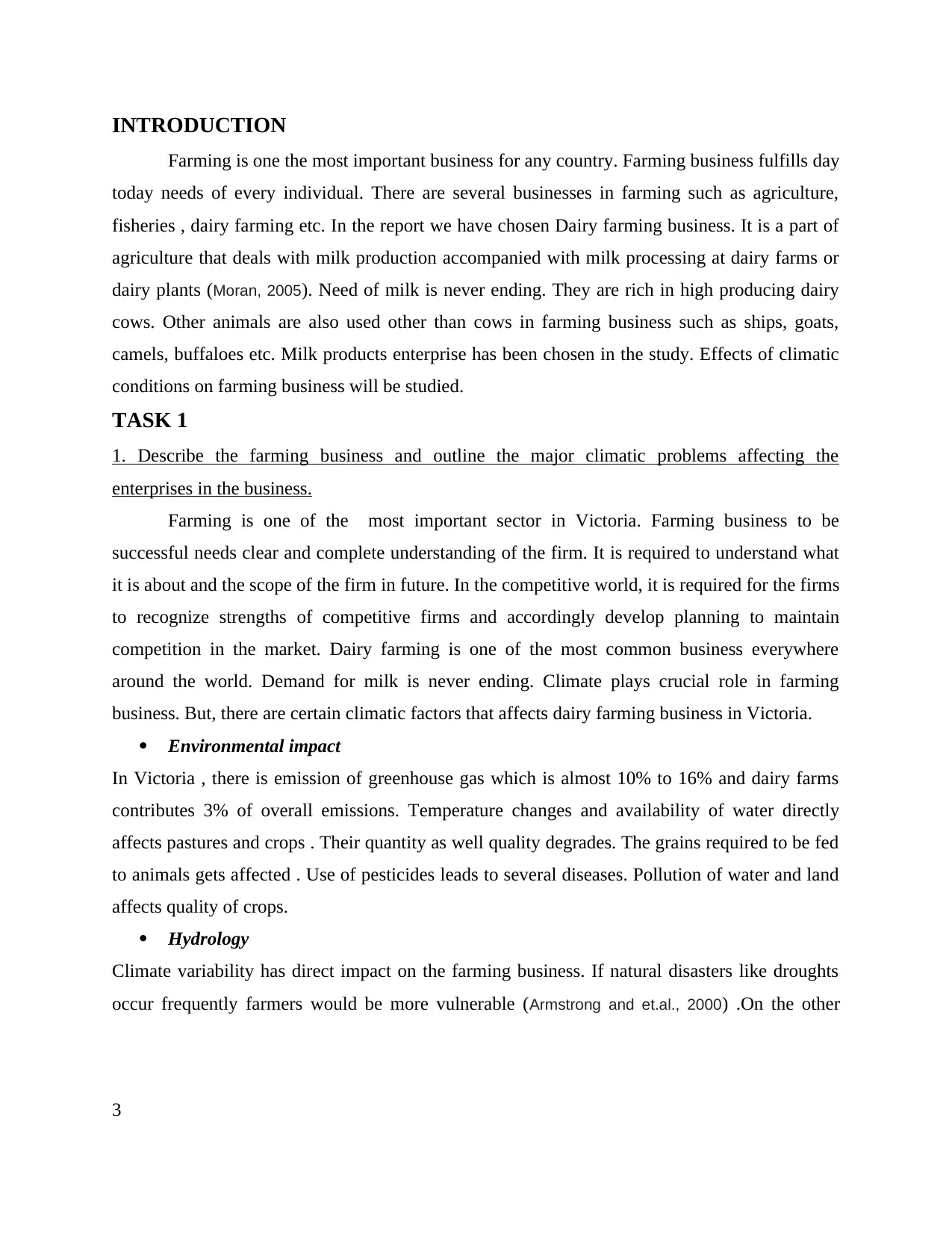
INTRODUCTION
Farming is one the most important business for any country. Farming business fulfills day
today needs of every individual. There are several businesses in farming such as agriculture,
fisheries , dairy farming etc. In the report we have chosen Dairy farming business. It is a part of
agriculture that deals with milk production accompanied with milk processing at dairy farms or
dairy plants (Moran, 2005). Need of milk is never ending. They are rich in high producing dairy
cows. Other animals are also used other than cows in farming business such as ships, goats,
camels, buffaloes etc. Milk products enterprise has been chosen in the study. Effects of climatic
conditions on farming business will be studied.
TASK 1
1. Describe the farming business and outline the major climatic problems affecting the
enterprises in the business.
Farming is one of the most important sector in Victoria. Farming business to be
successful needs clear and complete understanding of the firm. It is required to understand what
it is about and the scope of the firm in future. In the competitive world, it is required for the firms
to recognize strengths of competitive firms and accordingly develop planning to maintain
competition in the market. Dairy farming is one of the most common business everywhere
around the world. Demand for milk is never ending. Climate plays crucial role in farming
business. But, there are certain climatic factors that affects dairy farming business in Victoria.
Environmental impact
In Victoria , there is emission of greenhouse gas which is almost 10% to 16% and dairy farms
contributes 3% of overall emissions. Temperature changes and availability of water directly
affects pastures and crops . Their quantity as well quality degrades. The grains required to be fed
to animals gets affected . Use of pesticides leads to several diseases. Pollution of water and land
affects quality of crops.
Hydrology
Climate variability has direct impact on the farming business. If natural disasters like droughts
occur frequently farmers would be more vulnerable (Armstrong and et.al., 2000) .On the other
3
Farming is one the most important business for any country. Farming business fulfills day
today needs of every individual. There are several businesses in farming such as agriculture,
fisheries , dairy farming etc. In the report we have chosen Dairy farming business. It is a part of
agriculture that deals with milk production accompanied with milk processing at dairy farms or
dairy plants (Moran, 2005). Need of milk is never ending. They are rich in high producing dairy
cows. Other animals are also used other than cows in farming business such as ships, goats,
camels, buffaloes etc. Milk products enterprise has been chosen in the study. Effects of climatic
conditions on farming business will be studied.
TASK 1
1. Describe the farming business and outline the major climatic problems affecting the
enterprises in the business.
Farming is one of the most important sector in Victoria. Farming business to be
successful needs clear and complete understanding of the firm. It is required to understand what
it is about and the scope of the firm in future. In the competitive world, it is required for the firms
to recognize strengths of competitive firms and accordingly develop planning to maintain
competition in the market. Dairy farming is one of the most common business everywhere
around the world. Demand for milk is never ending. Climate plays crucial role in farming
business. But, there are certain climatic factors that affects dairy farming business in Victoria.
Environmental impact
In Victoria , there is emission of greenhouse gas which is almost 10% to 16% and dairy farms
contributes 3% of overall emissions. Temperature changes and availability of water directly
affects pastures and crops . Their quantity as well quality degrades. The grains required to be fed
to animals gets affected . Use of pesticides leads to several diseases. Pollution of water and land
affects quality of crops.
Hydrology
Climate variability has direct impact on the farming business. If natural disasters like droughts
occur frequently farmers would be more vulnerable (Armstrong and et.al., 2000) .On the other
3
⊘ This is a preview!⊘
Do you want full access?
Subscribe today to unlock all pages.

Trusted by 1+ million students worldwide
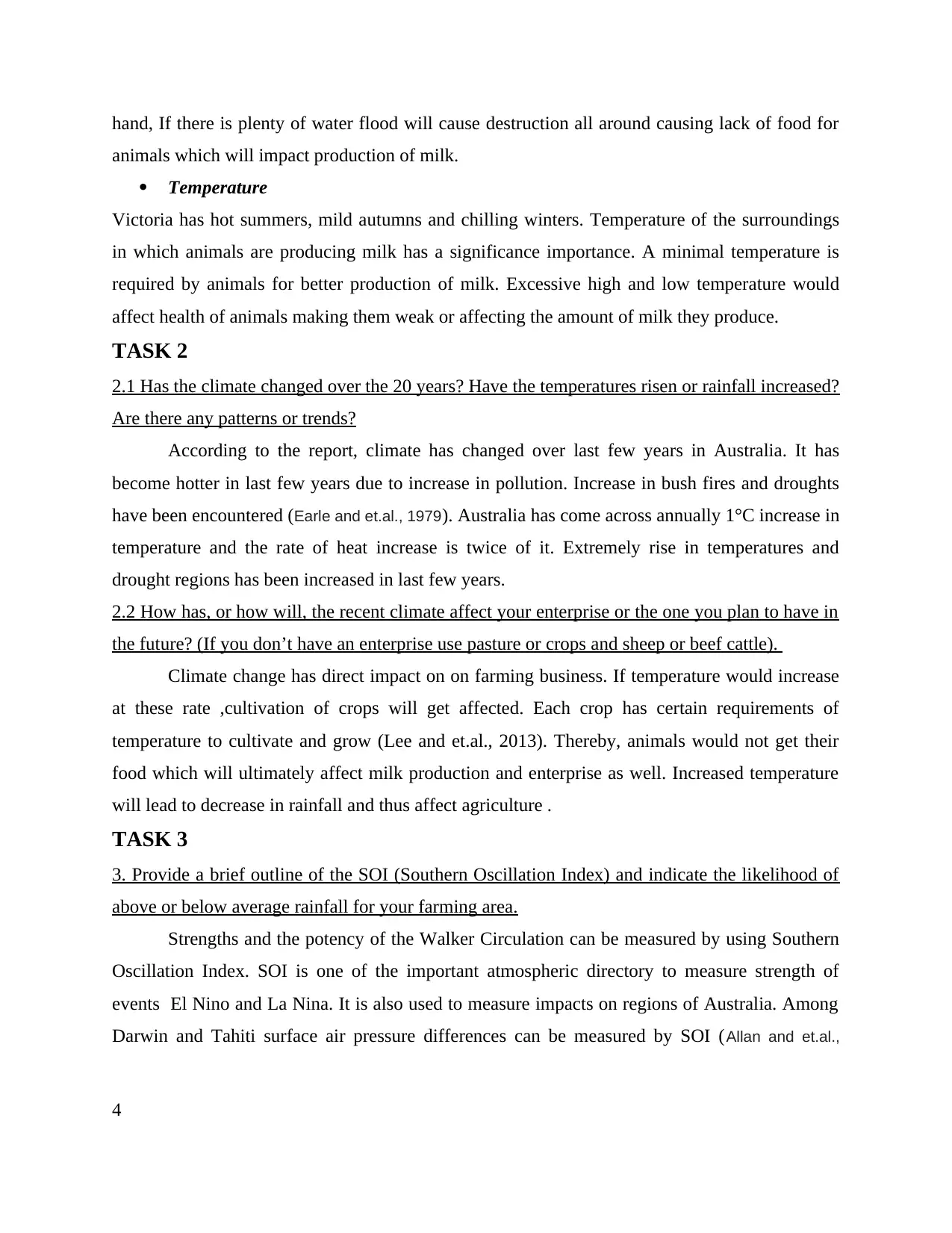
hand, If there is plenty of water flood will cause destruction all around causing lack of food for
animals which will impact production of milk.
Temperature
Victoria has hot summers, mild autumns and chilling winters. Temperature of the surroundings
in which animals are producing milk has a significance importance. A minimal temperature is
required by animals for better production of milk. Excessive high and low temperature would
affect health of animals making them weak or affecting the amount of milk they produce.
TASK 2
2.1 Has the climate changed over the 20 years? Have the temperatures risen or rainfall increased?
Are there any patterns or trends?
According to the report, climate has changed over last few years in Australia. It has
become hotter in last few years due to increase in pollution. Increase in bush fires and droughts
have been encountered (Earle and et.al., 1979). Australia has come across annually 1°C increase in
temperature and the rate of heat increase is twice of it. Extremely rise in temperatures and
drought regions has been increased in last few years.
2.2 How has, or how will, the recent climate affect your enterprise or the one you plan to have in
the future? (If you don’t have an enterprise use pasture or crops and sheep or beef cattle).
Climate change has direct impact on on farming business. If temperature would increase
at these rate ,cultivation of crops will get affected. Each crop has certain requirements of
temperature to cultivate and grow (Lee and et.al., 2013). Thereby, animals would not get their
food which will ultimately affect milk production and enterprise as well. Increased temperature
will lead to decrease in rainfall and thus affect agriculture .
TASK 3
3. Provide a brief outline of the SOI (Southern Oscillation Index) and indicate the likelihood of
above or below average rainfall for your farming area.
Strengths and the potency of the Walker Circulation can be measured by using Southern
Oscillation Index. SOI is one of the important atmospheric directory to measure strength of
events El Nino and La Nina. It is also used to measure impacts on regions of Australia. Among
Darwin and Tahiti surface air pressure differences can be measured by SOI (Allan and et.al.,
4
animals which will impact production of milk.
Temperature
Victoria has hot summers, mild autumns and chilling winters. Temperature of the surroundings
in which animals are producing milk has a significance importance. A minimal temperature is
required by animals for better production of milk. Excessive high and low temperature would
affect health of animals making them weak or affecting the amount of milk they produce.
TASK 2
2.1 Has the climate changed over the 20 years? Have the temperatures risen or rainfall increased?
Are there any patterns or trends?
According to the report, climate has changed over last few years in Australia. It has
become hotter in last few years due to increase in pollution. Increase in bush fires and droughts
have been encountered (Earle and et.al., 1979). Australia has come across annually 1°C increase in
temperature and the rate of heat increase is twice of it. Extremely rise in temperatures and
drought regions has been increased in last few years.
2.2 How has, or how will, the recent climate affect your enterprise or the one you plan to have in
the future? (If you don’t have an enterprise use pasture or crops and sheep or beef cattle).
Climate change has direct impact on on farming business. If temperature would increase
at these rate ,cultivation of crops will get affected. Each crop has certain requirements of
temperature to cultivate and grow (Lee and et.al., 2013). Thereby, animals would not get their
food which will ultimately affect milk production and enterprise as well. Increased temperature
will lead to decrease in rainfall and thus affect agriculture .
TASK 3
3. Provide a brief outline of the SOI (Southern Oscillation Index) and indicate the likelihood of
above or below average rainfall for your farming area.
Strengths and the potency of the Walker Circulation can be measured by using Southern
Oscillation Index. SOI is one of the important atmospheric directory to measure strength of
events El Nino and La Nina. It is also used to measure impacts on regions of Australia. Among
Darwin and Tahiti surface air pressure differences can be measured by SOI (Allan and et.al.,
4
Paraphrase This Document
Need a fresh take? Get an instant paraphrase of this document with our AI Paraphraser
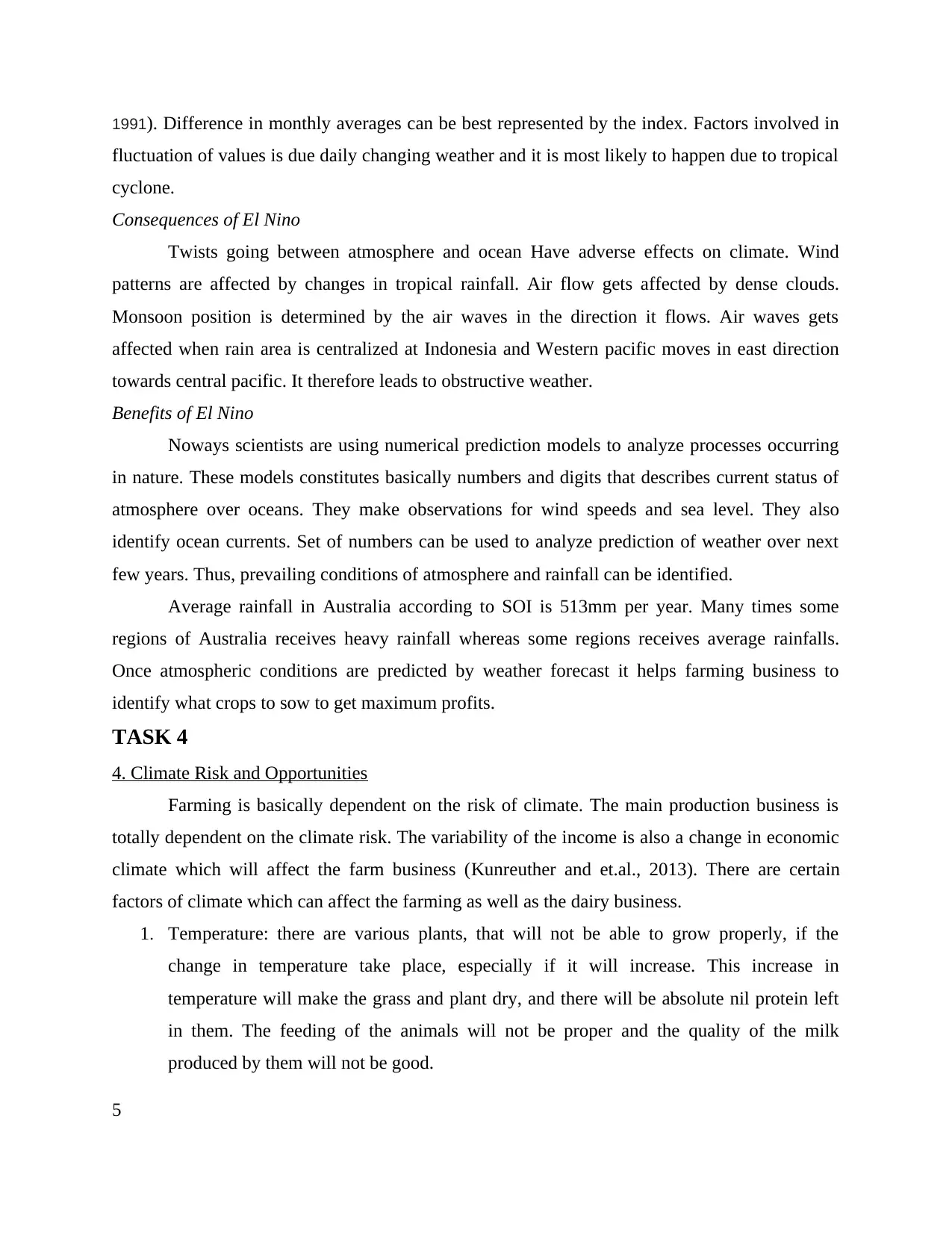
1991). Difference in monthly averages can be best represented by the index. Factors involved in
fluctuation of values is due daily changing weather and it is most likely to happen due to tropical
cyclone.
Consequences of El Nino
Twists going between atmosphere and ocean Have adverse effects on climate. Wind
patterns are affected by changes in tropical rainfall. Air flow gets affected by dense clouds.
Monsoon position is determined by the air waves in the direction it flows. Air waves gets
affected when rain area is centralized at Indonesia and Western pacific moves in east direction
towards central pacific. It therefore leads to obstructive weather.
Benefits of El Nino
Noways scientists are using numerical prediction models to analyze processes occurring
in nature. These models constitutes basically numbers and digits that describes current status of
atmosphere over oceans. They make observations for wind speeds and sea level. They also
identify ocean currents. Set of numbers can be used to analyze prediction of weather over next
few years. Thus, prevailing conditions of atmosphere and rainfall can be identified.
Average rainfall in Australia according to SOI is 513mm per year. Many times some
regions of Australia receives heavy rainfall whereas some regions receives average rainfalls.
Once atmospheric conditions are predicted by weather forecast it helps farming business to
identify what crops to sow to get maximum profits.
TASK 4
4. Climate Risk and Opportunities
Farming is basically dependent on the risk of climate. The main production business is
totally dependent on the climate risk. The variability of the income is also a change in economic
climate which will affect the farm business (Kunreuther and et.al., 2013). There are certain
factors of climate which can affect the farming as well as the dairy business.
1. Temperature: there are various plants, that will not be able to grow properly, if the
change in temperature take place, especially if it will increase. This increase in
temperature will make the grass and plant dry, and there will be absolute nil protein left
in them. The feeding of the animals will not be proper and the quality of the milk
produced by them will not be good.
5
fluctuation of values is due daily changing weather and it is most likely to happen due to tropical
cyclone.
Consequences of El Nino
Twists going between atmosphere and ocean Have adverse effects on climate. Wind
patterns are affected by changes in tropical rainfall. Air flow gets affected by dense clouds.
Monsoon position is determined by the air waves in the direction it flows. Air waves gets
affected when rain area is centralized at Indonesia and Western pacific moves in east direction
towards central pacific. It therefore leads to obstructive weather.
Benefits of El Nino
Noways scientists are using numerical prediction models to analyze processes occurring
in nature. These models constitutes basically numbers and digits that describes current status of
atmosphere over oceans. They make observations for wind speeds and sea level. They also
identify ocean currents. Set of numbers can be used to analyze prediction of weather over next
few years. Thus, prevailing conditions of atmosphere and rainfall can be identified.
Average rainfall in Australia according to SOI is 513mm per year. Many times some
regions of Australia receives heavy rainfall whereas some regions receives average rainfalls.
Once atmospheric conditions are predicted by weather forecast it helps farming business to
identify what crops to sow to get maximum profits.
TASK 4
4. Climate Risk and Opportunities
Farming is basically dependent on the risk of climate. The main production business is
totally dependent on the climate risk. The variability of the income is also a change in economic
climate which will affect the farm business (Kunreuther and et.al., 2013). There are certain
factors of climate which can affect the farming as well as the dairy business.
1. Temperature: there are various plants, that will not be able to grow properly, if the
change in temperature take place, especially if it will increase. This increase in
temperature will make the grass and plant dry, and there will be absolute nil protein left
in them. The feeding of the animals will not be proper and the quality of the milk
produced by them will not be good.
5
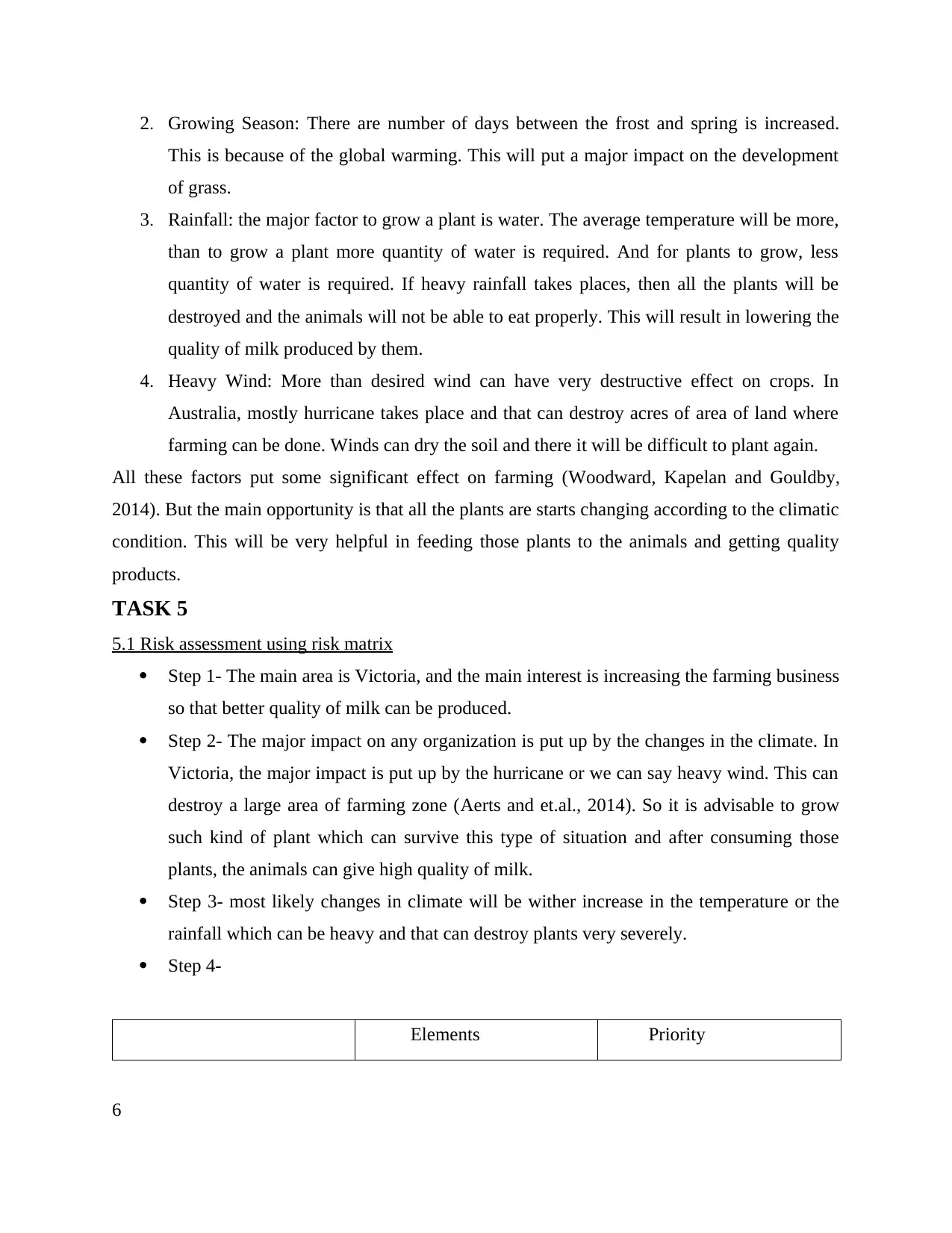
2. Growing Season: There are number of days between the frost and spring is increased.
This is because of the global warming. This will put a major impact on the development
of grass.
3. Rainfall: the major factor to grow a plant is water. The average temperature will be more,
than to grow a plant more quantity of water is required. And for plants to grow, less
quantity of water is required. If heavy rainfall takes places, then all the plants will be
destroyed and the animals will not be able to eat properly. This will result in lowering the
quality of milk produced by them.
4. Heavy Wind: More than desired wind can have very destructive effect on crops. In
Australia, mostly hurricane takes place and that can destroy acres of area of land where
farming can be done. Winds can dry the soil and there it will be difficult to plant again.
All these factors put some significant effect on farming (Woodward, Kapelan and Gouldby,
2014). But the main opportunity is that all the plants are starts changing according to the climatic
condition. This will be very helpful in feeding those plants to the animals and getting quality
products.
TASK 5
5.1 Risk assessment using risk matrix
Step 1- The main area is Victoria, and the main interest is increasing the farming business
so that better quality of milk can be produced.
Step 2- The major impact on any organization is put up by the changes in the climate. In
Victoria, the major impact is put up by the hurricane or we can say heavy wind. This can
destroy a large area of farming zone (Aerts and et.al., 2014). So it is advisable to grow
such kind of plant which can survive this type of situation and after consuming those
plants, the animals can give high quality of milk.
Step 3- most likely changes in climate will be wither increase in the temperature or the
rainfall which can be heavy and that can destroy plants very severely.
Step 4-
Elements Priority
6
This is because of the global warming. This will put a major impact on the development
of grass.
3. Rainfall: the major factor to grow a plant is water. The average temperature will be more,
than to grow a plant more quantity of water is required. And for plants to grow, less
quantity of water is required. If heavy rainfall takes places, then all the plants will be
destroyed and the animals will not be able to eat properly. This will result in lowering the
quality of milk produced by them.
4. Heavy Wind: More than desired wind can have very destructive effect on crops. In
Australia, mostly hurricane takes place and that can destroy acres of area of land where
farming can be done. Winds can dry the soil and there it will be difficult to plant again.
All these factors put some significant effect on farming (Woodward, Kapelan and Gouldby,
2014). But the main opportunity is that all the plants are starts changing according to the climatic
condition. This will be very helpful in feeding those plants to the animals and getting quality
products.
TASK 5
5.1 Risk assessment using risk matrix
Step 1- The main area is Victoria, and the main interest is increasing the farming business
so that better quality of milk can be produced.
Step 2- The major impact on any organization is put up by the changes in the climate. In
Victoria, the major impact is put up by the hurricane or we can say heavy wind. This can
destroy a large area of farming zone (Aerts and et.al., 2014). So it is advisable to grow
such kind of plant which can survive this type of situation and after consuming those
plants, the animals can give high quality of milk.
Step 3- most likely changes in climate will be wither increase in the temperature or the
rainfall which can be heavy and that can destroy plants very severely.
Step 4-
Elements Priority
6
⊘ This is a preview!⊘
Do you want full access?
Subscribe today to unlock all pages.

Trusted by 1+ million students worldwide
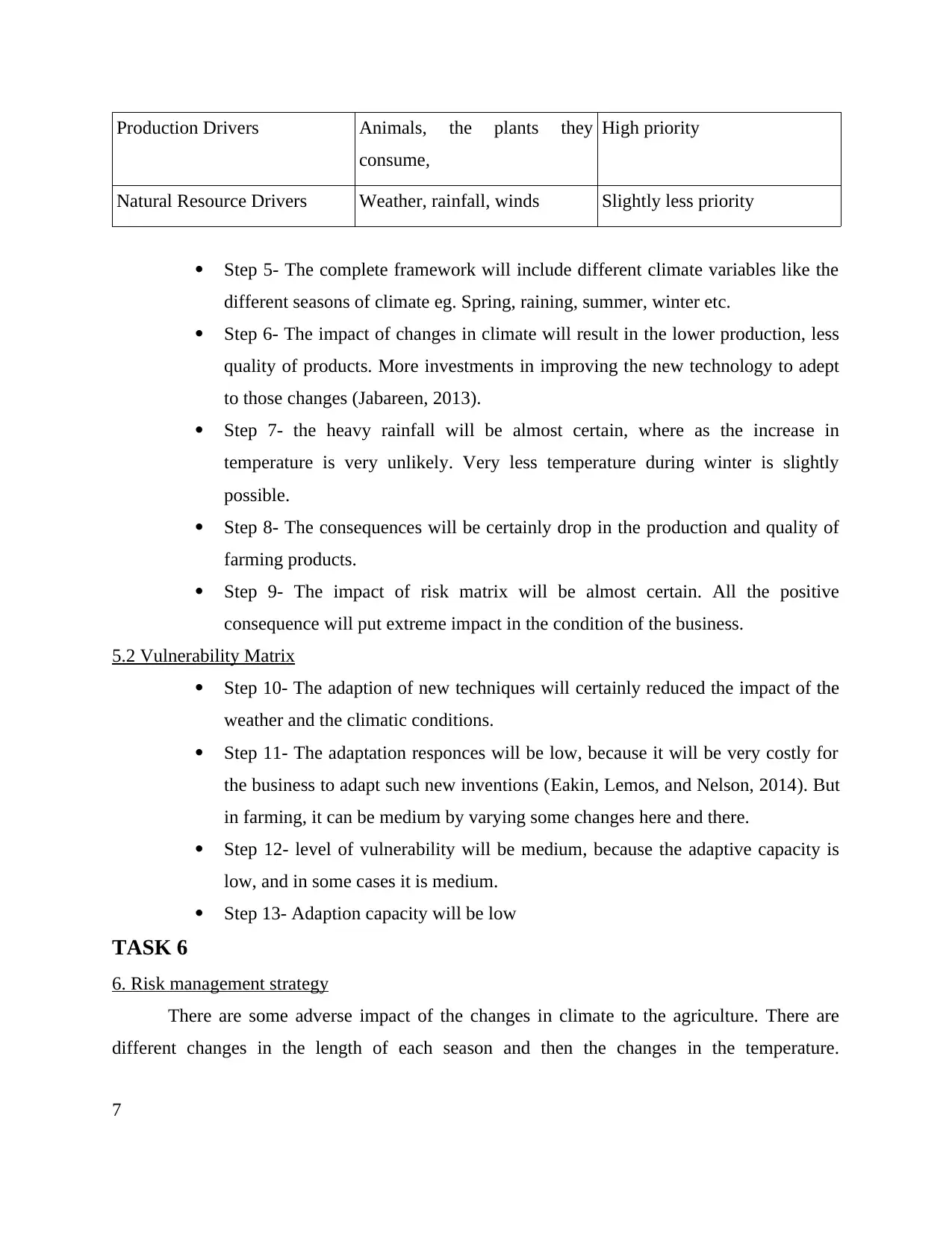
Production Drivers Animals, the plants they
consume,
High priority
Natural Resource Drivers Weather, rainfall, winds Slightly less priority
Step 5- The complete framework will include different climate variables like the
different seasons of climate eg. Spring, raining, summer, winter etc.
Step 6- The impact of changes in climate will result in the lower production, less
quality of products. More investments in improving the new technology to adept
to those changes (Jabareen, 2013).
Step 7- the heavy rainfall will be almost certain, where as the increase in
temperature is very unlikely. Very less temperature during winter is slightly
possible.
Step 8- The consequences will be certainly drop in the production and quality of
farming products.
Step 9- The impact of risk matrix will be almost certain. All the positive
consequence will put extreme impact in the condition of the business.
5.2 Vulnerability Matrix
Step 10- The adaption of new techniques will certainly reduced the impact of the
weather and the climatic conditions.
Step 11- The adaptation responces will be low, because it will be very costly for
the business to adapt such new inventions (Eakin, Lemos, and Nelson, 2014). But
in farming, it can be medium by varying some changes here and there.
Step 12- level of vulnerability will be medium, because the adaptive capacity is
low, and in some cases it is medium.
Step 13- Adaption capacity will be low
TASK 6
6. Risk management strategy
There are some adverse impact of the changes in climate to the agriculture. There are
different changes in the length of each season and then the changes in the temperature.
7
consume,
High priority
Natural Resource Drivers Weather, rainfall, winds Slightly less priority
Step 5- The complete framework will include different climate variables like the
different seasons of climate eg. Spring, raining, summer, winter etc.
Step 6- The impact of changes in climate will result in the lower production, less
quality of products. More investments in improving the new technology to adept
to those changes (Jabareen, 2013).
Step 7- the heavy rainfall will be almost certain, where as the increase in
temperature is very unlikely. Very less temperature during winter is slightly
possible.
Step 8- The consequences will be certainly drop in the production and quality of
farming products.
Step 9- The impact of risk matrix will be almost certain. All the positive
consequence will put extreme impact in the condition of the business.
5.2 Vulnerability Matrix
Step 10- The adaption of new techniques will certainly reduced the impact of the
weather and the climatic conditions.
Step 11- The adaptation responces will be low, because it will be very costly for
the business to adapt such new inventions (Eakin, Lemos, and Nelson, 2014). But
in farming, it can be medium by varying some changes here and there.
Step 12- level of vulnerability will be medium, because the adaptive capacity is
low, and in some cases it is medium.
Step 13- Adaption capacity will be low
TASK 6
6. Risk management strategy
There are some adverse impact of the changes in climate to the agriculture. There are
different changes in the length of each season and then the changes in the temperature.
7
Paraphrase This Document
Need a fresh take? Get an instant paraphrase of this document with our AI Paraphraser
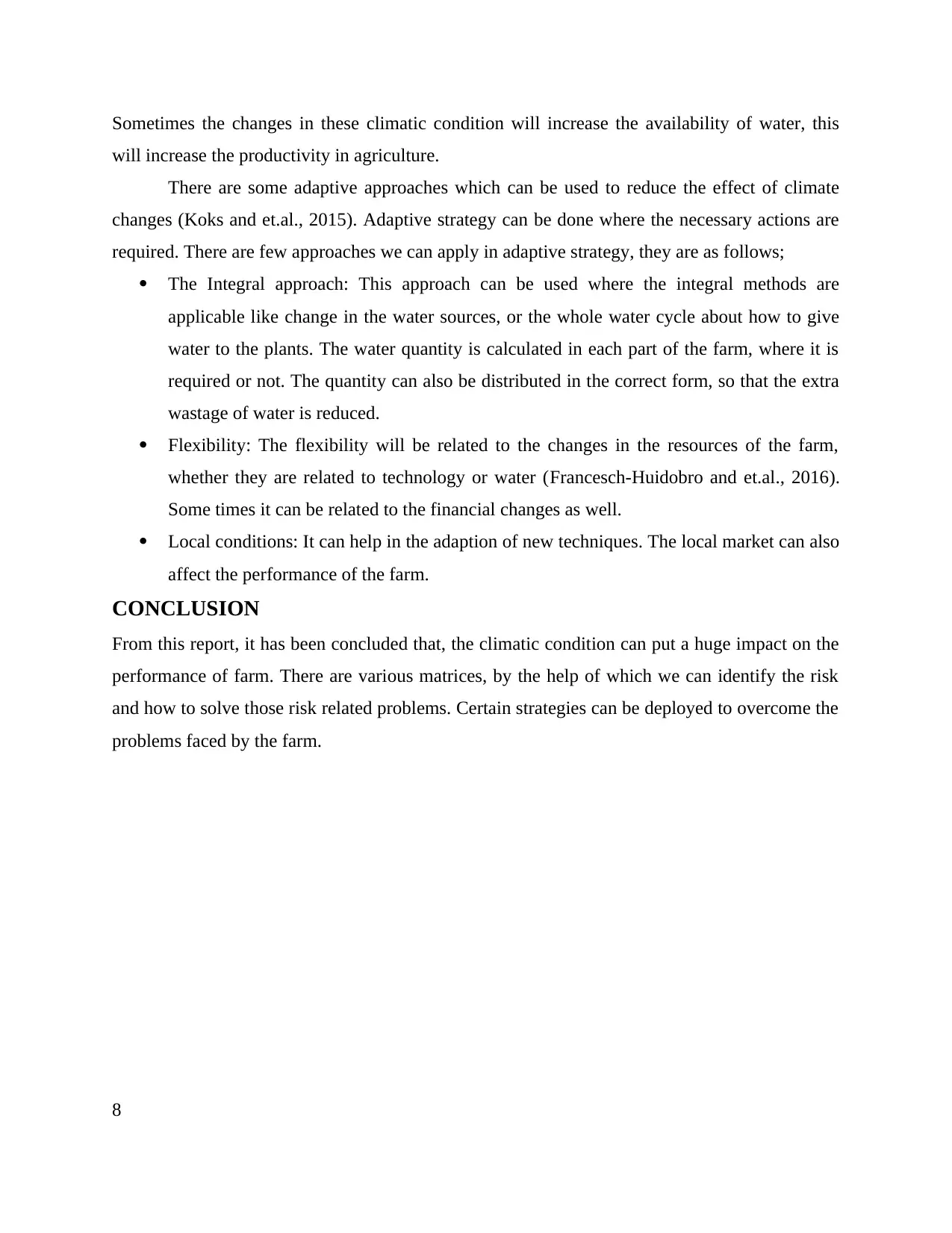
Sometimes the changes in these climatic condition will increase the availability of water, this
will increase the productivity in agriculture.
There are some adaptive approaches which can be used to reduce the effect of climate
changes (Koks and et.al., 2015). Adaptive strategy can be done where the necessary actions are
required. There are few approaches we can apply in adaptive strategy, they are as follows;
The Integral approach: This approach can be used where the integral methods are
applicable like change in the water sources, or the whole water cycle about how to give
water to the plants. The water quantity is calculated in each part of the farm, where it is
required or not. The quantity can also be distributed in the correct form, so that the extra
wastage of water is reduced.
Flexibility: The flexibility will be related to the changes in the resources of the farm,
whether they are related to technology or water (Francesch-Huidobro and et.al., 2016).
Some times it can be related to the financial changes as well.
Local conditions: It can help in the adaption of new techniques. The local market can also
affect the performance of the farm.
CONCLUSION
From this report, it has been concluded that, the climatic condition can put a huge impact on the
performance of farm. There are various matrices, by the help of which we can identify the risk
and how to solve those risk related problems. Certain strategies can be deployed to overcome the
problems faced by the farm.
8
will increase the productivity in agriculture.
There are some adaptive approaches which can be used to reduce the effect of climate
changes (Koks and et.al., 2015). Adaptive strategy can be done where the necessary actions are
required. There are few approaches we can apply in adaptive strategy, they are as follows;
The Integral approach: This approach can be used where the integral methods are
applicable like change in the water sources, or the whole water cycle about how to give
water to the plants. The water quantity is calculated in each part of the farm, where it is
required or not. The quantity can also be distributed in the correct form, so that the extra
wastage of water is reduced.
Flexibility: The flexibility will be related to the changes in the resources of the farm,
whether they are related to technology or water (Francesch-Huidobro and et.al., 2016).
Some times it can be related to the financial changes as well.
Local conditions: It can help in the adaption of new techniques. The local market can also
affect the performance of the farm.
CONCLUSION
From this report, it has been concluded that, the climatic condition can put a huge impact on the
performance of farm. There are various matrices, by the help of which we can identify the risk
and how to solve those risk related problems. Certain strategies can be deployed to overcome the
problems faced by the farm.
8
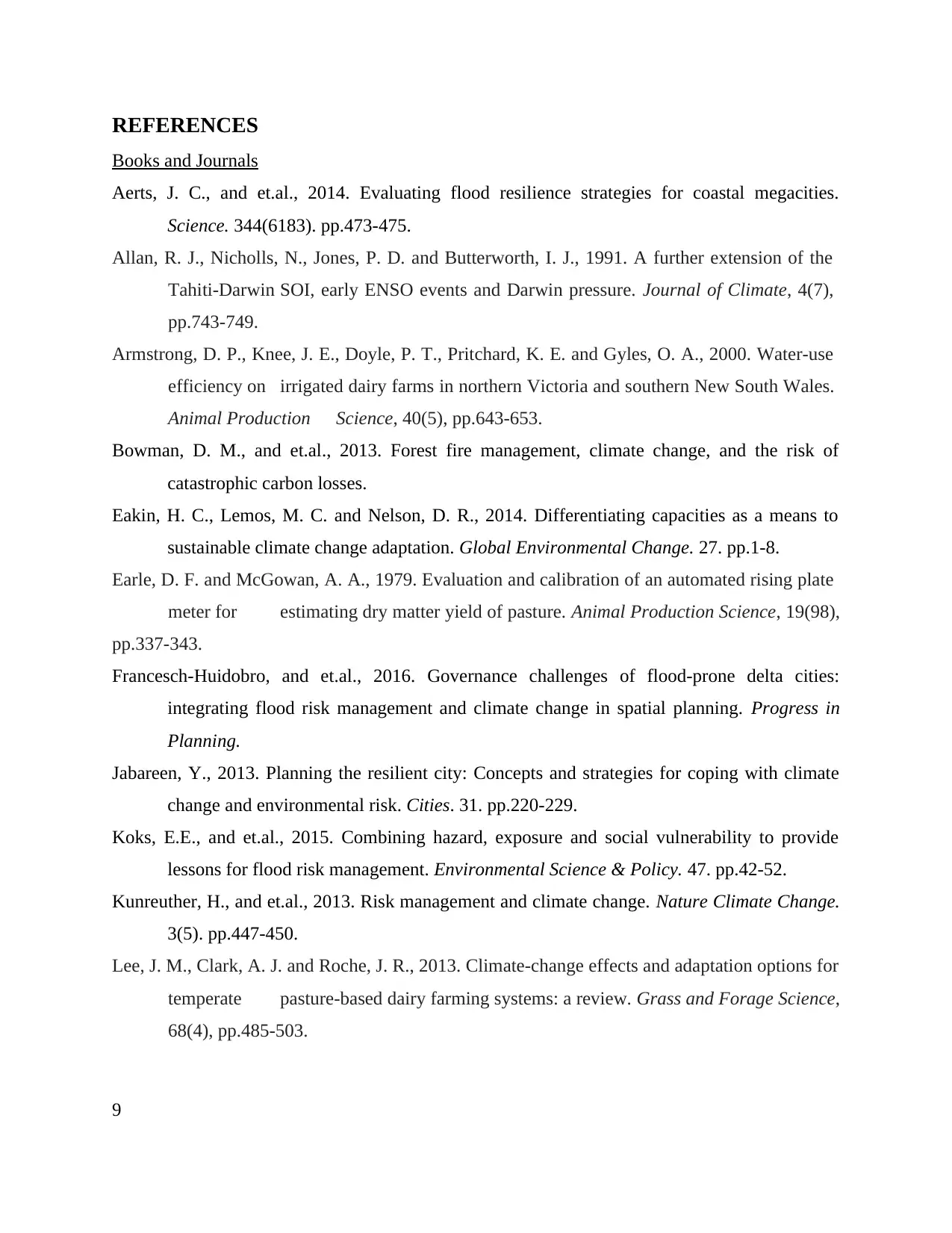
REFERENCES
Books and Journals
Aerts, J. C., and et.al., 2014. Evaluating flood resilience strategies for coastal megacities.
Science. 344(6183). pp.473-475.
Allan, R. J., Nicholls, N., Jones, P. D. and Butterworth, I. J., 1991. A further extension of the
Tahiti-Darwin SOI, early ENSO events and Darwin pressure. Journal of Climate, 4(7),
pp.743-749.
Armstrong, D. P., Knee, J. E., Doyle, P. T., Pritchard, K. E. and Gyles, O. A., 2000. Water-use
efficiency on irrigated dairy farms in northern Victoria and southern New South Wales.
Animal Production Science, 40(5), pp.643-653.
Bowman, D. M., and et.al., 2013. Forest fire management, climate change, and the risk of
catastrophic carbon losses.
Eakin, H. C., Lemos, M. C. and Nelson, D. R., 2014. Differentiating capacities as a means to
sustainable climate change adaptation. Global Environmental Change. 27. pp.1-8.
Earle, D. F. and McGowan, A. A., 1979. Evaluation and calibration of an automated rising plate
meter for estimating dry matter yield of pasture. Animal Production Science, 19(98),
pp.337-343.
Francesch-Huidobro, and et.al., 2016. Governance challenges of flood-prone delta cities:
integrating flood risk management and climate change in spatial planning. Progress in
Planning.
Jabareen, Y., 2013. Planning the resilient city: Concepts and strategies for coping with climate
change and environmental risk. Cities. 31. pp.220-229.
Koks, E.E., and et.al., 2015. Combining hazard, exposure and social vulnerability to provide
lessons for flood risk management. Environmental Science & Policy. 47. pp.42-52.
Kunreuther, H., and et.al., 2013. Risk management and climate change. Nature Climate Change.
3(5). pp.447-450.
Lee, J. M., Clark, A. J. and Roche, J. R., 2013. Climate‐change effects and adaptation options for
temperate pasture‐based dairy farming systems: a review. Grass and Forage Science,
68(4), pp.485-503.
9
Books and Journals
Aerts, J. C., and et.al., 2014. Evaluating flood resilience strategies for coastal megacities.
Science. 344(6183). pp.473-475.
Allan, R. J., Nicholls, N., Jones, P. D. and Butterworth, I. J., 1991. A further extension of the
Tahiti-Darwin SOI, early ENSO events and Darwin pressure. Journal of Climate, 4(7),
pp.743-749.
Armstrong, D. P., Knee, J. E., Doyle, P. T., Pritchard, K. E. and Gyles, O. A., 2000. Water-use
efficiency on irrigated dairy farms in northern Victoria and southern New South Wales.
Animal Production Science, 40(5), pp.643-653.
Bowman, D. M., and et.al., 2013. Forest fire management, climate change, and the risk of
catastrophic carbon losses.
Eakin, H. C., Lemos, M. C. and Nelson, D. R., 2014. Differentiating capacities as a means to
sustainable climate change adaptation. Global Environmental Change. 27. pp.1-8.
Earle, D. F. and McGowan, A. A., 1979. Evaluation and calibration of an automated rising plate
meter for estimating dry matter yield of pasture. Animal Production Science, 19(98),
pp.337-343.
Francesch-Huidobro, and et.al., 2016. Governance challenges of flood-prone delta cities:
integrating flood risk management and climate change in spatial planning. Progress in
Planning.
Jabareen, Y., 2013. Planning the resilient city: Concepts and strategies for coping with climate
change and environmental risk. Cities. 31. pp.220-229.
Koks, E.E., and et.al., 2015. Combining hazard, exposure and social vulnerability to provide
lessons for flood risk management. Environmental Science & Policy. 47. pp.42-52.
Kunreuther, H., and et.al., 2013. Risk management and climate change. Nature Climate Change.
3(5). pp.447-450.
Lee, J. M., Clark, A. J. and Roche, J. R., 2013. Climate‐change effects and adaptation options for
temperate pasture‐based dairy farming systems: a review. Grass and Forage Science,
68(4), pp.485-503.
9
⊘ This is a preview!⊘
Do you want full access?
Subscribe today to unlock all pages.

Trusted by 1+ million students worldwide
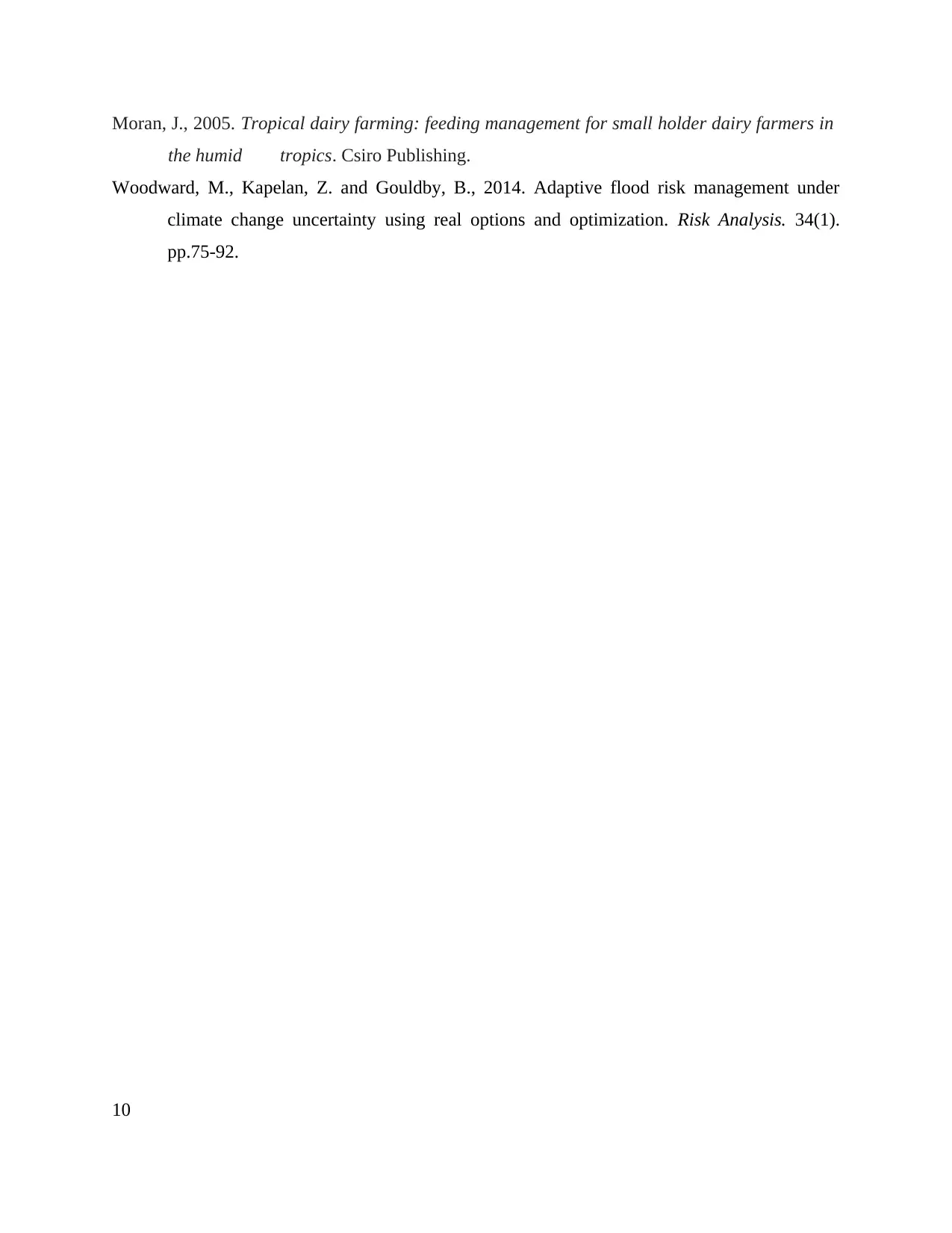
Moran, J., 2005. Tropical dairy farming: feeding management for small holder dairy farmers in
the humid tropics. Csiro Publishing.
Woodward, M., Kapelan, Z. and Gouldby, B., 2014. Adaptive flood risk management under
climate change uncertainty using real options and optimization. Risk Analysis. 34(1).
pp.75-92.
10
the humid tropics. Csiro Publishing.
Woodward, M., Kapelan, Z. and Gouldby, B., 2014. Adaptive flood risk management under
climate change uncertainty using real options and optimization. Risk Analysis. 34(1).
pp.75-92.
10
1 out of 10
Related Documents
Your All-in-One AI-Powered Toolkit for Academic Success.
+13062052269
info@desklib.com
Available 24*7 on WhatsApp / Email
![[object Object]](/_next/static/media/star-bottom.7253800d.svg)
Unlock your academic potential
Copyright © 2020–2025 A2Z Services. All Rights Reserved. Developed and managed by ZUCOL.




